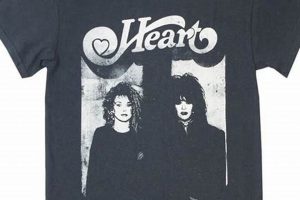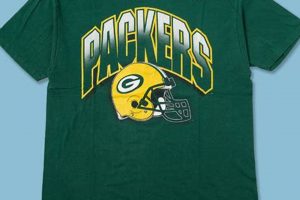Apparel from past eras featuring the legendary rock band, the Rolling Stones, holds significant collectible value. These garments, often made of materials no longer commonly used, display graphics and designs representative of specific tours or album releases. A well-preserved example can command a substantial price in the collectors’ market.
The importance of such items lies in their connection to rock music history and their tangible representation of a specific cultural moment. Benefits for collectors include potential appreciation in value and the personal satisfaction derived from owning a piece of music memorabilia. Their historical context provides insights into fashion trends and the band’s evolving image throughout their career.
This article will delve into the characteristics that distinguish authentic pieces from reproductions, explore the factors influencing their value, and provide guidance on proper care and storage to maintain their condition for future generations.
Tips for Identifying and Preserving Vintage Rolling Stones Shirts
Acquiring and maintaining authentic Rolling Stones apparel requires careful consideration. The following tips provide guidance on authentication, preservation, and storage.
Tip 1: Examine the Fabric and Construction. Original items often utilize single-stitch construction, particularly on the sleeves and hem. Modern reproductions frequently employ double-stitched seams for increased durability and cost-effectiveness, offering a key differentiation point.
Tip 2: Scrutinize the Graphic Quality. Screen-printed designs on older shirts exhibit a specific texture and slight imperfections. Modern printing techniques produce a smoother, more uniform appearance. Microscopic examination can reveal inconsistencies indicative of modern reproduction.
Tip 3: Analyze the Tag Details. Vintage tags typically display specific brand names and sizing conventions prevalent during the shirt’s production era. Researching vintage tag styles can aid in determining authenticity. Absence of a tag, or a tag inconsistent with the assumed age, warrants further investigation.
Tip 4: Assess the Overall Condition. While some wear and tear are expected in older garments, excessive damage or inconsistencies should raise concerns. Carefully inspect for stains, holes, or graphic fading that seems disproportionate to the shirt’s supposed age.
Tip 5: Compare to Known Authentic Examples. Consult reputable online resources, collector’s guides, or museum archives to compare the shirt in question to documented authentic examples. Pay close attention to design variations, color palettes, and printing techniques.
Tip 6: Consider the Era and Tour Details. Research the specific tour or album associated with the design. Ensure the design aligns with the known artwork and merchandise produced during that period. Discrepancies in design elements may suggest a reproduction or unauthorized merchandise.
Tip 7: Implement Proper Storage Techniques. To preserve the integrity of vintage pieces, store them in a cool, dark, and dry environment. Avoid direct sunlight and excessive humidity. Consider using acid-free tissue paper for added protection during storage.
Tip 8: Handle with Care During Cleaning. When cleaning is necessary, opt for gentle hand-washing using a mild detergent specifically formulated for delicate fabrics. Avoid harsh chemicals or machine washing, which can damage the fabric and graphics.
Adhering to these tips increases the likelihood of acquiring authentic vintage apparel and ensures its long-term preservation, thereby safeguarding its historical and collectible value.
The next section will address the factors influencing the market value of these items and offer guidance on navigating the complexities of the vintage apparel market.
1. Authenticity Verification
The verification of authenticity is paramount when assessing a vintage Rolling Stones shirt. Due to the potential for misrepresentation and the proliferation of reproductions, establishing the genuine nature of a garment is the foundational step in determining its value and historical significance. The inability to verify authenticity renders the shirt, at best, a modern replica with limited collector appeal, and at worst, a deliberate attempt to deceive.
The connection between “vintage Rolling Stones shirt” and “authenticity verification” is causal; authentic shirts from specific eras, tours, or album releases hold inherent value because they represent a tangible link to a particular moment in music history. For example, a shirt from the 1972 “Exile on Main St.” tour, if authenticated through examination of its construction, graphics, and tag details, commands a significantly higher price than a modern reproduction. Authenticity is therefore not merely a desirable attribute but an intrinsic component of the item’s worth. Practical significance lies in the ability of collectors to confidently invest in pieces that accurately reflect the band’s legacy and cultural impact.
In summary, the stringent evaluation of a shirt’s origin is non-negotiable in the vintage market. Establishing authenticity ensures that the item accurately represents its historical context and retains its collector value. The challenges associated with identifying legitimate pieces underscore the need for informed diligence and a thorough understanding of the characteristics that differentiate original garments from modern imitations. This process protects the integrity of the vintage market and ensures that the band’s legacy is preserved accurately.
2. Graphic Condition
The state of the graphic design on a vintage Rolling Stones shirt directly impacts its value and collectibility. Degradation, fading, cracking, or significant loss of the original artwork diminishes the shirt’s aesthetic appeal and authenticity. A pristine graphic suggests careful preservation or limited use, indicating higher desirability among collectors. Conversely, substantial damage may render the item less desirable, reducing its market price. As an example, two shirts from the same tour, each featuring an identical design, will command markedly different prices based solely on the relative integrity of their respective graphics. The graphic’s condition serves as a primary visual indicator of the shirt’s overall state, reflecting the care with which it was handled throughout its existence. This factor has practical significance for both sellers seeking to maximize returns and buyers aiming to acquire valuable pieces for their collections.
The connection between the graphic’s appearance and perceived value is often amplified by the specific design featured on the shirt. Certain iconic designs, such as the “Tongue and Lips” logo in its earliest iterations, are highly sought after. When such designs are exceptionally well-preserved, the corresponding shirts can fetch premium prices. However, even minor imperfections in these coveted graphics can lead to substantial price reductions. This highlights the importance of carefully examining the graphic details, including color vibrancy, line sharpness, and overall clarity. Collectors often employ specialized lighting and magnification tools to assess the graphic condition accurately before making purchasing decisions. Furthermore, understanding the printing techniques used during the shirt’s era of production is crucial; variations in ink types, screen-printing methods, and fabric preparation can all influence how the graphic has aged over time.
In summary, the graphic condition is a critical determinant of value for any vintage Rolling Stones shirt. This facet serves as a tangible link to the past, embodying the band’s image and artistic expression. Collectors understand that preserving these graphics is paramount to maintaining the shirt’s collectibility and historical significance. Recognizing the nuances of graphic assessment, including potential damage and degradation, empowers buyers and sellers to make informed decisions in the vintage market. Over time, the visual impact of the graphic continues to dictate much of a shirt’s appeal, affirming its essential role in preserving the legacy of the Rolling Stones.
3. Fabric Quality
The composition and condition of the fabric are critical determinants of a vintage Rolling Stones shirt’s value and desirability. Fabric quality not only affects the garment’s structural integrity and longevity but also serves as an indicator of its authenticity and historical context.
- Material Composition
The types of fabric used in vintage shirts varied across different eras. Early shirts often featured lightweight cotton, while later decades introduced blends with polyester or rayon. The specific composition can help identify the shirt’s period of origin, as certain materials were more prevalent during particular years. For instance, a shirt advertised as being from the 1960s but containing a high percentage of polyester would immediately raise concerns about its authenticity. The material’s feel, drape, and breathability also impact its overall appeal to collectors.
- Weave and Knit Structure
The weave or knit structure of the fabric influences its durability, texture, and aesthetic qualities. Single-knit jerseys were common in earlier shirts, while interlock knits offered greater stability in later models. The tightness and uniformity of the weave can indicate the quality of the original manufacturing process. A loosely woven or unevenly knitted fabric might suggest a lower-quality or counterfeit garment. Moreover, the presence of slubs, imperfections, or variations in the weave can provide clues about the manufacturing techniques of the time, aiding in authentication efforts.
- Fabric Condition and Wear
The extent of wear and tear on the fabric is a significant factor in assessing a vintage shirt’s value. Minor imperfections, such as small holes or slight fading, might be acceptable, particularly if they align with the shirt’s age and usage. However, extensive damage, significant staining, or fabric disintegration can severely diminish its desirability. Collectors often prioritize shirts with minimal wear, indicating careful preservation over the years. Evaluating the fabric’s structural integrity, including seam strength and elasticity, is essential to gauge its long-term viability.
- Color Retention and Dye Quality
The vibrancy and evenness of the fabric’s color are crucial indicators of its overall quality and preservation. Fading, discoloration, or color bleeding can detract from the shirt’s aesthetic appeal and may suggest exposure to sunlight, improper washing, or inferior dye quality. Vintage shirts produced with high-quality dyes often exhibit better color retention, even after decades of use. Assessing the color fastness and uniformity of the dye can provide insights into the shirt’s manufacturing standards and its ability to withstand the passage of time.
The fabric quality of a “vintage Rolling Stones shirt” is thus intrinsically linked to its authenticity, historical context, and collector value. A thorough examination of the material composition, weave structure, condition, and color retention allows for a comprehensive assessment of the garment’s origin and its place within the broader landscape of rock and roll memorabilia.
4. Era Identification
Era identification is a critical component in evaluating a “vintage Rolling Stones shirt” due to the band’s extensive career and evolving aesthetic. The specific era in which a shirt was produced directly influences its design, fabric, printing techniques, and overall value. Incorrectly attributing a shirt to the wrong period can lead to inaccurate pricing and misrepresentation in the collectors’ market. For example, a shirt mistakenly identified as originating from the 1960s, when in reality it dates to the 1980s, would likely be overvalued and misrepresented. Understanding the nuances of each era allows for accurate assessment and informed purchasing decisions.
Practical application of era identification involves analyzing various elements of the shirt. The tag design, for instance, often provides crucial clues. Certain tag styles were prevalent during specific decades, and comparing a tag to established resources can help determine the shirt’s approximate age. Similarly, the style of graphic design reflects prevailing trends of the time. Shirts from the early 1970s often feature bolder, more psychedelic designs compared to the minimalist graphics common in the 1990s. By meticulously examining these details and cross-referencing them with known tour dates and album releases, one can narrow down the shirt’s potential origin. This process can be time-consuming but essential for ensuring the authenticity and accurate valuation of the item.
In summary, era identification represents a significant challenge in the vintage apparel market but is indispensable for assessing the worth of any “vintage Rolling Stones shirt.” Successfully dating a shirt requires diligent research, attention to detail, and familiarity with the band’s history and visual evolution. The ability to accurately identify a shirt’s era ensures that it is properly valued, accurately represented, and appreciated within its correct historical context, contributing to the overall integrity of the vintage collectibles market.
5. Tag Analysis
The examination of tags affixed to vintage Rolling Stones shirts constitutes a critical step in determining authenticity, era of production, and overall value. Tag analysis provides tangible evidence that can corroborate or contradict claims regarding a shirt’s origin, offering valuable insights into its manufacturing history.
- Brand Identification
Tags often bear the brand name of the apparel manufacturer, which can be cross-referenced with known licensing agreements and production periods associated with the Rolling Stones. Specific brands were prevalent during certain eras, and their presence or absence on a shirt can serve as a preliminary indicator of authenticity. For instance, the presence of a brand known to have ceased operations before a particular tour date would raise immediate concerns regarding the shirt’s claimed origin.
- Sizing and Material Information
Tags typically include sizing information and details about the fabric composition. Variations in sizing conventions and material blends across different decades provide further clues about the shirt’s age. The presence of sizing designations inconsistent with historical practices, or the inclusion of materials not yet in common use during the claimed production period, would suggest a potential discrepancy.
- Country of Origin
Tags often indicate the country of origin, which can be compared with known manufacturing locations for officially licensed Rolling Stones merchandise. Shirts produced in countries not associated with official production channels may warrant closer scrutiny. Changes in trade agreements and manufacturing practices over time mean that specific countries of origin can be tied to certain eras.
- Copyright and Trademark Information
Tags may display copyright or trademark symbols and dates associated with the Rolling Stones logo or other related imagery. Examining the accuracy and consistency of this information with documented records can help verify the shirt’s authenticity. The absence of proper copyright notices or the presence of outdated trademark symbols may indicate an unauthorized reproduction.
In summary, tag analysis represents an essential component of authenticating a vintage Rolling Stones shirt. By meticulously examining the brand identification, sizing information, country of origin, and copyright details, collectors can gain valuable insights into the garment’s history and assess its legitimacy within the broader context of rock and roll memorabilia.
6. Rarity Factor
The rarity factor significantly influences the valuation and desirability of any vintage Rolling Stones shirt. Scarce shirts command premium prices due to their limited availability and increased collectibility. Several elements contribute to a shirt’s overall rarity, impacting its position in the vintage market.
- Limited Production Runs
Shirts produced in small quantities, often for specific events or promotions, are inherently rarer. Examples include shirts created exclusively for crew members during a tour or those released in limited edition runs for fan club members. These shirts are less likely to surface in the resale market, increasing their desirability among collectors. A shirt from a one-off concert or a promotional item distributed only at a single record store appearance can fetch a significantly higher price than mass-produced tour merchandise. This limited availability translates directly into increased value.
- Design Variations and Errors
Shirts featuring unique design variations, printing errors, or prototype designs are highly sought after due to their distinctiveness. These deviations from the standard design make them exceptionally rare. For example, a shirt with a misprinted logo or an unreleased design element can become a prized possession for collectors. Such errors or variations are often discovered years after the initial production, adding to their mystique and collectibility. The presence of such anomalies elevates the shirt’s rarity beyond typical vintage merchandise.
- Tour-Specific Merchandise
Shirts associated with specific tours, particularly those from early or less publicized tours, are often rarer than general merchandise. These shirts serve as tangible reminders of a specific time and place in the band’s history. A shirt from the Rolling Stones’ 1969 US tour, for instance, is significantly more valuable than a shirt featuring the band’s logo without a specific tour affiliation. The tour-specific nature of the merchandise connects it to a particular moment in the band’s career, increasing its historical significance and rarity.
- Regional Exclusivity
Shirts produced and sold exclusively in certain geographic regions are considered rarer than those widely distributed. For example, a shirt designed specifically for the Japanese market or a concert held in a small European city would be less common in other parts of the world. These regional variations add to the shirt’s uniqueness and collectibility. The limited distribution area means fewer shirts were produced, making them harder to find and more valuable to collectors seeking unique items.
These facets of rarity directly influence the value and desirability of any vintage Rolling Stones shirt. Understanding the factors contributing to scarcity allows collectors and enthusiasts to identify and appreciate the most exceptional pieces of memorabilia, preserving the band’s legacy through tangible artifacts.
Frequently Asked Questions
The following questions address common inquiries concerning vintage Rolling Stones apparel, offering clarity on key aspects of identification, valuation, and preservation.
Question 1: What constitutes a “vintage” Rolling Stones shirt?
Generally, a garment produced at least twenty years prior to the present date is considered vintage. However, in the context of rock memorabilia, shirts from earlier periods, particularly those associated with specific tours or album releases from the 1960s, 1970s, and 1980s, are most highly regarded.
Question 2: How can authenticity of a vintage Rolling Stones shirt be verified?
Authenticity can be assessed through careful examination of several factors, including the fabric composition, stitching style (e.g., single-stitch construction), tag details (brand, sizing, country of origin), and graphic quality. Comparison with known authentic examples and consultation with reputable collectors are also recommended.
Question 3: What factors most significantly influence the value of a vintage Rolling Stones shirt?
Key determinants of value include authenticity, condition of the graphic and fabric, rarity (based on production quantity and tour association), era of production, and overall demand from collectors. Shirts associated with iconic tours or featuring unique designs generally command higher prices.
Question 4: What are the primary risks associated with purchasing vintage Rolling Stones shirts online?
The principal risk is the acquisition of counterfeit or misrepresented items. Buyers should exercise caution and thoroughly scrutinize product listings, request detailed photographs, and seek assurances regarding authenticity and condition before making a purchase.
Question 5: How should a vintage Rolling Stones shirt be properly stored to prevent damage?
Optimal storage involves a cool, dry, and dark environment, away from direct sunlight and excessive humidity. Acid-free tissue paper can be used to protect the garment during storage, and hanging should be avoided to prevent stretching or distortion.
Question 6: Is professional cleaning recommended for vintage Rolling Stones shirts?
Professional cleaning is advisable for delicate or heavily soiled items. Select a reputable cleaner experienced in handling vintage fabrics and ensure they employ gentle, non-abrasive cleaning methods. Avoid harsh chemicals or machine washing, which can damage the fabric and graphics.
Understanding these key considerations is essential for both collectors and sellers of vintage Rolling Stones shirts, ensuring informed decisions and the preservation of valuable musical memorabilia.
The subsequent article segment will explore the role of vintage apparel in preserving the legacy of the Rolling Stones and its cultural impact.
Concluding Remarks on Preserving a Rock and Roll Legacy
This article has explored the multifaceted aspects of acquiring, authenticating, and preserving a “vintage Rolling Stones shirt”. Key areas covered include identification techniques, factors influencing valuation, and proper storage methods. Emphasis was placed on discerning authentic items from reproductions and the importance of meticulous examination in establishing provenance.
The enduring appeal of the “vintage Rolling Stones shirt” lies in its tangible connection to a pivotal era in music history. These garments serve as artifacts, embodying the band’s cultural impact and artistic expression. Continued diligence in preservation efforts ensures that future generations can appreciate these significant pieces of rock and roll memorabilia, safeguarding a vital element of our collective cultural heritage.







